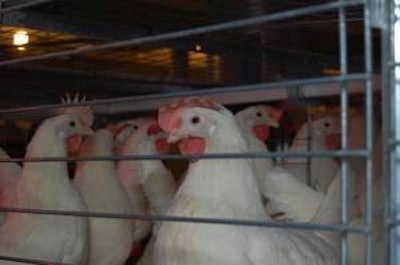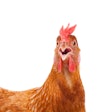
The Iowa Egg Industry Symposium sponsored and organized by the Iowa State University College of Veterinary Medicine and ISU Extension has become the major fall education forum for egg producers in the Midwest region. This year’s program drew around 200 attendees from 18 states and four countries. The presentations focused on the current feed ingredient supply situation; animal welfare agreements, certification and management; and strategies to control Salmonella enteritidis in your flock.
Genetics and animal welfare
Dr. Neil O’Sullivan, director of research and development, Hy-Line International, explained how breeders make selections and accomplish the annual rates of genetic improvement they do in laying hen genetic stock. He said that breeders have grouped over 30 traits into five different categories, production, animal well-being, egg quality, efficiency and reproduction.
In the production group, age at first egg is measured in all hens at the individual or family group level. Typically, this has resulted in hens maturing almost one day earlier each year. Peak rate of lay improves annually, but since peaks of over 95% are now the norm, a slower response can be expected in the future. Persistency of production has a lot of genetic variation, and annually flocks stay above 90% and later 80% production for four to five more days each year.
The animal well-being group has focused on livability and resistance to Marek’s disease in the past, but is being revitalized with a focus on selection in group environments for traits such as dominance, fear response, nesting behavior and feather loss. Selection for feather coverage has proved to be a good animal well-being trait, because birds that are poorly feathered are often those which are poorly adapted to the environment. O’Sullivan said that selection in group environments has ensured that birds, which are not beak trimmed, with low social dominance drive are selected as they share resources well, such as feed and water access. These birds also create a positive social environment with low levels of social stress, and ensure equal access to feed, water, nesting areas and perch space. Direct selection against excessive fearfulness has ensured calm but highly adapted hens. In the last decade, O’Sullivan reports that breeders have restarted direct selection for nest use and that this has proved to be a heritable trait.
In the egg quality group, selection for egg quality is made by measurement of a shell quality Bio-complex index, which is a multiple trait analysis of eggshell breaking strength, puncture score and packing strength (acoustic egg score). A strong correlation between egg shell quality and animal well-being is important. Selection for group performance in the efficiency group of traits is important. Decreasing dominance of hens will assist in good social bird behavior. Much progress has been made over recent years to reduce residual feed usage in layers, thereby significantly decreasing feed conversion ratios for egg production. This emphasis will continue. Modern genomics data combined with progeny group tests maximizes identification of individual males and females with the best genes for 32 traits in total for selection of the top 2-3% males and top 10-12% females. This modern breeding program will help move the leghorn hen into the future with emphasis on hen welfare and well-being.
American Humane Certified
Rich Musselman, field operations manager, American Humane Association, presented information about the American Humane Association (a different organization from the HSUS) and their history. They provided the first animal welfare certification program in the U.S., and provide voluntary third party audits of animal welfare for multiple species, beef, pork, dairy and poultry. Their standards were developed by animal science experts, veterinarians and animal husbandry practitioners and are reviewed regularly by a scientific advisory committee.
An egg producer can become a “Certified Producer” in one of three layer management alternatives: enriched colony housing, cage-free or free-range. Each management system must provide room for the hens to stand up, sit down, turn around, and extend their wings; adequate food and water; and enrichments to meet the hen’s behavioral needs for nesting, perching, and scratching.
American Humane defines enriched colony housing as hens raised in small groups with all previously mentioned enrichments. Cage-free environments can be on the floor or in aviaries and may include outdoor access. Free range includes access to pasture with protection from predators and night-time shelter.
The American Humane Certified program has “added value partnerships” with the James Beard Foundation, Viking Cooking Schools and The Humane Table.
Feed outlook for 2012
The current feed situation was well addressed by Dr. Chad Hart, ISU grain markets specialist. He predicted decreased demand for corn in the poultry and livestock sectors into 2012, but continued strong pricing for corn due to limited stocks. Soybean exports to China have decreased, which has helped decrease demand in soybean meal markets. Demand and use for DDGS is stable, with 20-25% of DDGS exported in 2011. Use of DDGS in livestock and poultry feeds will surpass use of soybean meal in 2012. His concerns for 2012 included possible drought in the Midwest and overall economic recession.
Salmonella control
Three presentations focusing on strategies for control of Salmonella enteritidis in the layer house were given at the symposium. Dr. Maxcy P. Nolan, NIPCAM Group, presented very practical information for a coordinated poultry pest management program. According to the FDA Egg Safety Rule, producers must have a plan to monitor, control and keep records for pests such as insects and rodents. In the case of an audit or inspection, the FDA will want to see your plan and records for carrying out your plan. Rodents are documented carriers of SE and must be kept under control. You can try to do it with your house labor or you can contract with a pest management specialist to help with a plan and to implement it efficiently, but it is not an easy task. After all of the rodent and pest graphics, I was a bit scared to go home and inspect our university facilities. Sanitation is most important; control of trash, vegetation around the house, spilled feed, leaking drinkers can all lead to a pest situation getting out of hand quickly. Fortunately, there are good management tools, chemicals and professional guidance to help a producer put together their plan, monitoring system and control. It is not an option, but a requirement now.
Cleaning and disinfection
Luc Ledoux, business unit manager, CID Lines, gave a thorough presentation about cleaning and disinfection in the house to control SE. He presented some very interesting data on cleaning and sanitizing egg belts that I had not seen or thought about before. Ledoux said that the egg belt can be a source of SE contamination for the freshly laid egg. Eggs are at the body temperature of the hen when laid and begin cooling down towards room temperature when coming into contact with ambient air and the egg belt. Any fecal dust present in the air of the layer house can settle on the egg belt and become a source of contamination. Ledoux said that salmonella reductions can be obtained by disinfecting egg belts and conveyors during production. He said that the disinfectant selected for use on egg belts must be approved by FDA for food contact, not cause staining, and must not leave a residual. It is important to make sure that the egg belts are dry prior to the time the hens start laying each day.
For house cleaning, Ledoux recommended use of an oxidizer type of cleaning agent for the best results. Foam and gel-types of cleansers increase contact time and thus efficiency of disinfection. Thermo fogging was recommended as the best way to clean cages without corrosion issues.
Salmonella enteritidis vaccination
An SE vaccination program is a critical component of the egg producers management strategy to control SE. Dr. I. Alvarado, Lohmann Animal Health International, presented very practical and useful information about vaccination options to prevent SE in layers. Both live and inactivated vaccines for Salmonella are available. The live vaccines stimulate cell mediated immunity helping to clear Salmonella from internal organs resulting in a reduction of Salmonella shedding in the environment. In contrast, inactivated vaccine stimulates the production of antibodies which provide protection not only to the hens but also during production to the internal contents of the egg. Combined vaccination programs using both forms of vaccine are recommended for the greatest risk reduction.

















